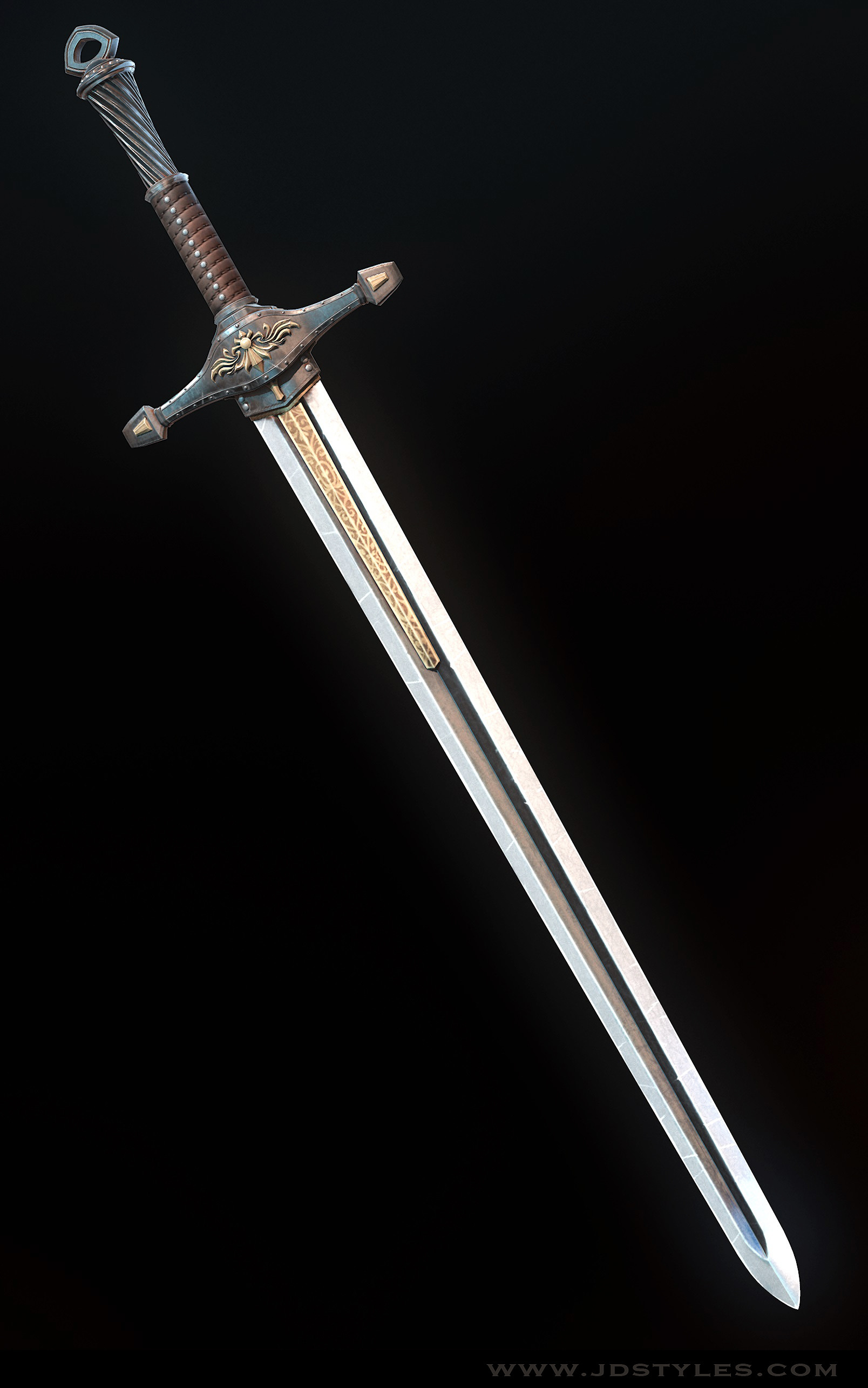Alastor, Variant (5e Race)
From D&D Wiki
Alastor[edit]
The prospect of a spirit entering an object is not especially unknown, though the common folk often take them as stories or superstition. While seemingly outlandish, a flying sword is actually much more plausible, though its apparent volition is only in animating magic. There is an overlap, then, of a sword in particular possessed by a spirit to give it a will rather than the wiles of a mad mage, appearing entirely like an animated object yet being its very own individual all the same.
Physical Description[edit]

|
|---|
| Image by JD Styles |
Alastors appear to be little more than hovering swords of many kinds. Even its distinctive feature, a pale glow as it hovers in the air, can be easily mistaken for things of a similar though more magical nature. As an alastor lives, it will begin to develop particular markings or designs of sorts on its vessel, further setting it apart from the standard of weaponry and from other alastors such as itself. Along with these innately appearing marks as an alastor comes to its own, so too would its vessel be marked by the damage of the environment and in battle. Unless magically maintained by itself, or maintained by another, an alastor's age becomes more and more evident.
History[edit]
All living creatures have a spirit, though most simply enter the afterlife. Only a spirit with a burning desire to achieve a certain objective remains in the realm of the living, usually unseen by most still-living creatures. These spirits may possess objects or other people to achieve this end, and to an extent, alastors are no different. However, what makes an alastor special when compared to a flying sword or a poltergeist is the permanent conjoining of spirit and sword, akin to a creature being reincarnated.
Society[edit]
Alastors do not have a society, and not from an innate ire towards each other, but rather because they tend to integrate into already existing society instead. As with people, alastors join those that they are accepted by, whether that means a single person, a party, a village, or greater. Although, there is often a greater interest toward alastors coming from the magical community compared to many others, intent on studying their oddity existence.
Alastor Names[edit]
Alastors typically keep the names they had in life and, as such, can derive their names from any language, usually one matching their former ethnicity. For example, a former elf may adopt a new elvish name. An alastor can just as easily make a new name for themselves as they pleased.
Alastor Traits[edit]
The spirits that inhabit swords, dependent on their bodies but with more liberty than there often is in death.
Ability Score Increase. Your Constitution score increases by 1, and one other ability score of your choice increases by 2.
Age. It is not known whether alastors have a lifespan or not, but without proper maintenance their vessels begin to deteriorate either with rust, erosion, or simply the damage sustained from battle. In this case, alastors will eventually chip so much away that their vessel can no longer act as a tether for the spirit, effectively dying. The oldest known alastor, a warrior family's heirloom, only lived as long as 250 years.
Alignment. Alastors' alignments are as varied as the humanoids they were originally, but alastors are often the product of a greater ambition or drive. Your alignment can be any alignment, tending toward the extremes.
Size. Alastors inhabit bladed weaponry, and as such, can be anywhere around 8 to 72 inches long, depending on what sword they inhabit. Your size is determined by your subrace.
Speed. Your base walking speed is 0 feet.
Iron Eyes and Ears. You can perceive the world around you from your vessel despite lacking the physical attributes to do so. You can see, hear, and feel, but cannot smell or taste.
Body of a Blade. Your body is a sword. Your creature type is both construct and undead, and you gain the following stipulations that come with it:
• You cannot wield weapons or shields, wear armor, or use objects. You also have disadvantage on checks that would normally require using hands.
• You are immune to poison damage, as well as the paralyzed, petrified, poisoned, and prone conditions.
• You do not need to eat, drink, or breathe.
• You don't sleep and magic can't put you to sleep. Instead, you enter an inert state for 4 hours while remaining fully conscious to gain the benefits of a long rest.
False Appearance. While motionless and not hovering, you are indistinguishable from a normal sword.
I Have No Mouth. You can communicate mentally with any willing creature you can see within 60 feet of you. This form of telepathy allows only you to send messages, and creatures can only understand you if you share a language. Your connection to a creature is broken if the creature is more than 60 feet away or if either of you mentally break the contact (no action required).
Whetstone Will. The tenacity of an alastor is powerful enough that it need not a hand to refine itself. You can attune to a magical weapon that is the same as your vessel, absorbing it into your body and gaining its magical effects. For example, you can attune to a +1 longsword and gain a +1 to the attack and damage rolls of your unarmed strikes. This process is long and exhausting, taking four hours of meditation in a long rest, at the end of which you become attuned but do not gain the benefits of a long rest.
Languages. You can read Common and one other language that you spoke in life.
Subrace. Alastors inhabit swords of all kinds. Choose a subrace between Greatsword, Longsword, Rapier, Shortsword, and Dagger, which serves as your body.
Greatsword[edit]
Your spirit inhabits a greatsword, a bulky weapon made to hack through enemies.
Blade. Your unarmed strike deals 1d12 slashing damage on a hit and counts as a heavy, two-handed weapon, but it can't be used for abilities like monk's martial arts or flurry of blows. Additionally, you can shove a creature as a bonus action.
Size. Your size is Medium.
Speed. You have a flying speed of 25 feet and can hover.
Natural Armor. While unarmored, your AC equals 13 + your Dexterity modifier.
Longsword[edit]
Your spirit inhabits a longsword, a versatile weapon often wielded by a knight.
Blade. Your unarmed strike deals 1d10 slashing damage on a hit and counts as a versatile weapon, but it can't be used for abilities like monk's martial arts or flurry of blows. Additionally, you count as one size larger when determining your carrying capacity and the weight you can push, drag, or lift.
Size. Your size is Small.
Speed. You have a flying speed of 30 feet and can hover.
Natural Armor. While unarmored, your AC equals 14 + your Dexterity modifier.
Rapier[edit]
Your spirit inhabits a rapier, an elegant weapon of precisely deadly strikes.
Blade. Your unarmed strike deals 1d8 piercing damage on a hit and counts as a finesse, one-handed weapon, but it can't be used for abilities like monk's martial arts or flurry of blows. You can use your Dexterity modifier for your unarmed strikes, rather than your Strength modifier. Additionally, you can move half your speed as a bonus action.
Size. Your size is Small.
Speed. You have a flying speed of 30 feet and can hover.
Natural Armor. Your AC equals 14 + your Dexterity modifier.
Shortsword[edit]
Your spirit inhabits a shortsword, a weapon held in defense or in pairs.
Blade. Your unarmed strike deals 1d6 piercing damage on a hit and counts as a finesse, light, one-handed weapon, but it can't be used for abilities like monk's martial arts or flurry of blows. You can use your Dexterity modifier for your unarmed strikes, rather than your Strength modifier. Additionally, you can attack once at disadvantage as a bonus action.
Size. Your size is Small.
Speed. You have a flying speed of 40 feet and can hover.
Natural Armor. Your AC equals 15 + your Dexterity modifier.
Dagger[edit]
Your spirit inhabits a dagger, a little deadly weapon used by the covert .
Blade. Your unarmed strike deals 1d4 piercing damage on a hit and counts as a finesse, light, one-handed weapon, but it can't be used for abilities like monk's martial arts or flurry of blows. You can use your Dexterity modifier for your unarmed strikes, rather than your Strength modifier. Additionally, you can move through the space of creatures larger than you.
Size. Your size is Tiny.
Speed. You have a flying speed of 40 feet and can hover.
Natural Armor. Your AC equals 15 + your Dexterity modifier.
Back to Main Page → 5e Homebrew → Races



